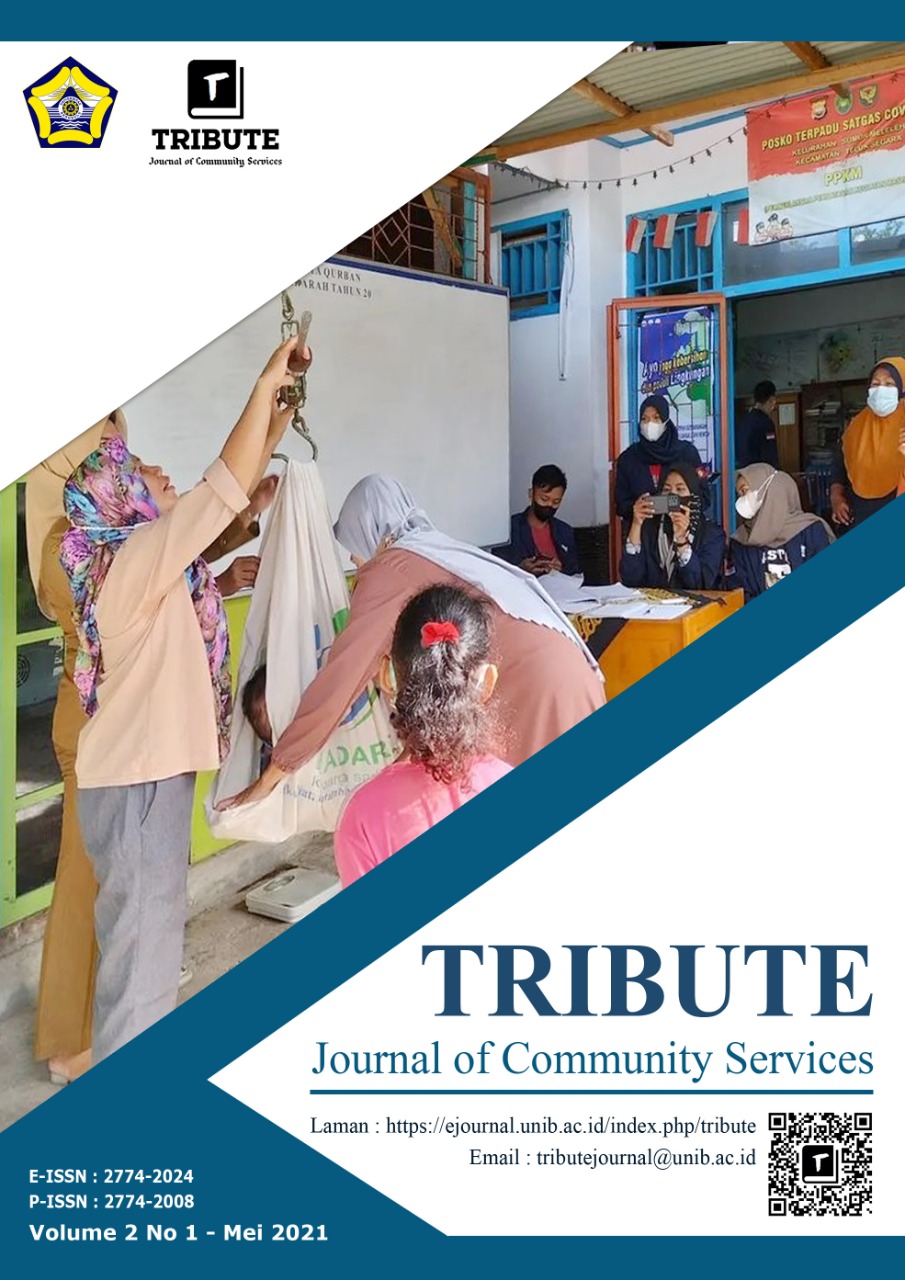Main Article Content
Abstract
Sektor pertanian menjadi salah satu yang terdampak pandemi COVID 19 sehingga dapat mengancam pemenuhan pangan di Indonesia. Pemerintah menggalakkan ketahanan pangan mandiri dengan cara memanfaatkan lahan pekarangan rumah untuk memenuhi kebutuhan pangan keluarga. Efisiensi biaya pemeliharaan tanaman dapat dilakukan dengan penggunaan pupuk cair buatan sendiri, salah satunya pupuk rumput laut. Pupuk rumput laut yang dihasilkan pada kegiatan ini berupa pupuk cair hasil ekstraksi rumput laut hijau dan cokelat. Metode ekstraksi menggunakan metode maserasi atau perendaman selama 14 hari. Metode yang sederhana dengan bahan yang mudah didapat berpotensi menjadikan pupuk cair rumput laut sebagai penyubur tanaman yang dapat meningkatkan hasil produksi tanaman.
MANUFACTURE OF ORGANIC LIQUID FERTILIZER FROM SEAWEEDS TO INCREASE PRODUCTION OF PLANTS IN RT 03 KELURAHAN TANJUNG JAYA KOTA BENGKULU. The agricultural sector is one of the areas affected by the COVID 19 pandemic and can threaten food fulfillment in Indonesia. The government promote independent food security by utilizing their home yards to fullfill the family food needs. The efficiency of plant maintenance costs can be done by using homemade liquid fertilizers, one of which is seaweeds fertilizer. The seaweeds fertilizer that produced in this activity is liquid fertilizer from the extraction of green and brown seaweeds. The extraction method uses the maceration method or soaking for 14 days. A simple method with abundant materials has the potential to make liquid seaweeds fertilizer as plant fertilizers that can increase crop production.
Article Details
Copy this form and after filling it, please send it to tributejournal@unib.ac.id
COPYRIGHT TRANSFER STATEMENT
When this article is accepted for publication, its copyright is transferred to TRIBUTE : JOURNAL OF COMMUNITY SERVICES. The copyright transfer covers the right to reproduce and distribute the article, including reprints, translations, photographic reproductions, microform, electronic form (offline, online) or any other reproductions of similar nature. This is copyright transfer statement (Download) for signed by the corresponding author.
The author warrants that this article is original and that the author has full power to publish. The author signs for and accepts responsibility for releasing this material on behalf of any and all co-authors. In regard to all kind of plagiarism in this manuscript, if any, only the author(s) will take full responsibility.
All articles published Open Access will be immediately and permanently free for everyone to read and download. We are continuously working with our author communities to select the best choice of license options, currently being defined for this journal as follows:
• Creative Commons Attribution-ShareAlike (CC BY-SA)

TRIBUTE : JOURNAL OF COMMUNITY SERVICES is licensed under a Creative Commons Attribution-ShareAlike 4.0 International License.
you are free to:
Share — copy and redistribute the material in any medium or format
Adapt — remix, transform, and build upon the material
for any purpose, even commercially.
The licensor cannot revoke these freedoms as long as you follow the license terms.
References
- Cocozza, C., Parente, A., Zaccone, C., Mininni, C., Santamaria, P. & Miano, T. (2011). Comparative management of offshore posidonia residues: composting vs. energy recovery. Waste Management (Oxford) 31: 78–84.
- Dhargalkar, V.K. & Pereira, N. (2005). Seaweed: promising plant of the millennium. Science and Culture. 71: 60–66.
- Fornes, F., Sanchez, P.M., & Guadiola, J.L. (2002). Effect of a seaweed extract on the productivity of ‘de Nules’ Clementine mdanarin navelina orange. Botanica Marina. 45: 486–489.
- Haslam, S.F.I. & Hopkins, D.W. (1996). Physical dan biological effects of kelp (seaweed) added to soil. Applied Soil Ecology. 3: 257–261.
- Padhi, S.B. & Swain, P.K. (2006). Effective Role of Microorganism dan Seaweed as Biofertilizer in Organic Farming for a Sustainable Environment. http://wgbis.ces.iisc.rnet.in/energy/lake2006/ programme/programme/proceedings/ fullpaper_pdfs/Sailabala%20Padhi.pdf. Diakses pada tanggal 13 Oktober 2020.
- Prithiviraj, B. (2009). Seaweed extracts as biostimulants of plant growth dan development. Plant Growth Regulation. 28: 386–399.
- Sedayu, B.B., Basmal, J. & Utomo, B.S.B. (2013). Identifikasi hormon pemacu tumbuh ekstrak cairan (sap) Eucheuma cottonii. Jurnal Pascapanen dan Bioteknologi Kelautan dan Perikanan. 8(1): 1–8.
- Sivasankari, S., Venkatesalu, V., Anantharaj, M., & Chdanrasekaran, M. (2006). Bioresource Technology 97: 1745–1751.
References
Cocozza, C., Parente, A., Zaccone, C., Mininni, C., Santamaria, P. & Miano, T. (2011). Comparative management of offshore posidonia residues: composting vs. energy recovery. Waste Management (Oxford) 31: 78–84.
Dhargalkar, V.K. & Pereira, N. (2005). Seaweed: promising plant of the millennium. Science and Culture. 71: 60–66.
Fornes, F., Sanchez, P.M., & Guadiola, J.L. (2002). Effect of a seaweed extract on the productivity of ‘de Nules’ Clementine mdanarin navelina orange. Botanica Marina. 45: 486–489.
Haslam, S.F.I. & Hopkins, D.W. (1996). Physical dan biological effects of kelp (seaweed) added to soil. Applied Soil Ecology. 3: 257–261.
Padhi, S.B. & Swain, P.K. (2006). Effective Role of Microorganism dan Seaweed as Biofertilizer in Organic Farming for a Sustainable Environment. http://wgbis.ces.iisc.rnet.in/energy/lake2006/ programme/programme/proceedings/ fullpaper_pdfs/Sailabala%20Padhi.pdf. Diakses pada tanggal 13 Oktober 2020.
Prithiviraj, B. (2009). Seaweed extracts as biostimulants of plant growth dan development. Plant Growth Regulation. 28: 386–399.
Sedayu, B.B., Basmal, J. & Utomo, B.S.B. (2013). Identifikasi hormon pemacu tumbuh ekstrak cairan (sap) Eucheuma cottonii. Jurnal Pascapanen dan Bioteknologi Kelautan dan Perikanan. 8(1): 1–8.
Sivasankari, S., Venkatesalu, V., Anantharaj, M., & Chdanrasekaran, M. (2006). Bioresource Technology 97: 1745–1751.
